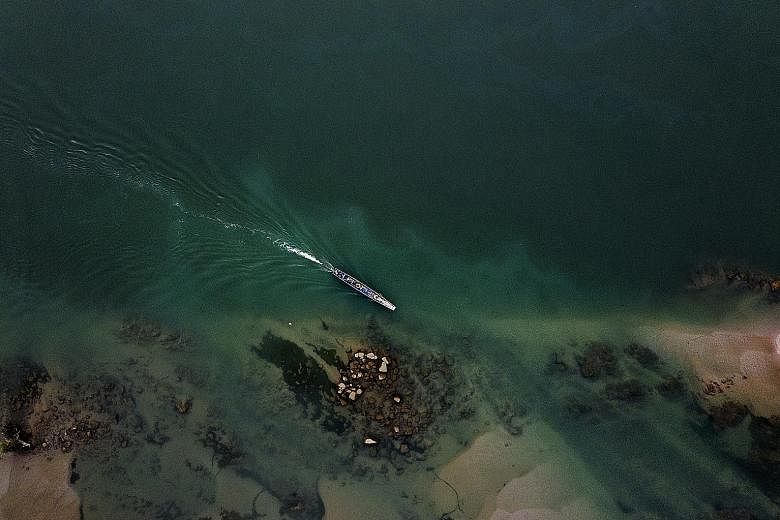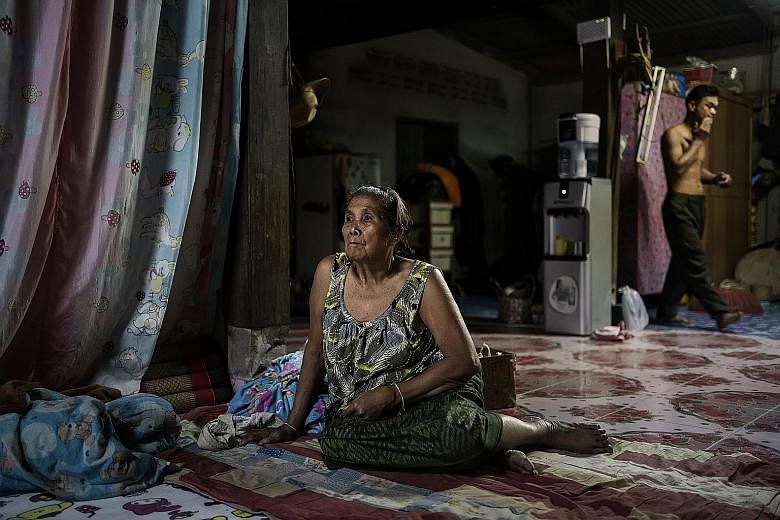NONG KHAI (Thailand) • The water is so clear in the Mekong River in northeastern Thailand that the sunlight pierces through to the riverbed, transforming the waterway into a glinting, empty aquarium. It is beautiful - but it means death.
At this time of year in Thailand, this stretch of the world's most productive river should be brown and swollen with silt. Instead, a prolonged drought and a huge new dam over the border in Laos, the first on the lower Mekong, have stolen the nutrients needed to sustain life.
On another bend, the Mekong almost disappears entirely, a trickle of stagnant water surrounded by a lunar landscape of sere hillocks and desiccated roots. This is the season that fish normally spawn here, but there is no water.
"Our nets are almost empty," said Mr Buorot Chaokhao, who has fished the Mekong's waters in Nong Khai, Thailand, just across the riverine border from Laos, for nearly five decades. "Maybe our way of life on the river is finished."
The lower Mekong, which makes its way through five countries, was one of the world's few remaining free rivers. But a hydropower boom, coupled with extreme weather patterns attributed to climate change, is radically remaking the waterway.
In October, the turbines of the first lower Mekong dam, the Xayaburi, began churning upstream from Nong Khai in Laos after a series of test runs last summer. The effect of the Thai-funded dam was almost immediate, residents said.
The Mekong ran clear and depleted, appearing an eerie, luminescent blue on sunny days. Algae bloomed, choking nets.
Now a months-long drought has pushed the water level even lower so that parts of the river are no longer a waterway at all but a desert of dead plants and dried-out crustaceans.
With about 10 more dams planned for the mainstream Mekong's lower reaches and hundreds more on its tributaries, a lifeline for 60 million people is being choked.
Tens of millions more will be affected as farms and fisheries are compromised, even as the rich and powerful across the region profit from the hydropower business.
"We're asking the question: Is this the breaking point for the Mekong?" said Mr Brian Eyler, director of the Stimson Centre's Southeast Asia programme and author of Last Days Of The Mighty Mekong.
"The Mekong's ecosystem is adaptable and resilient, but the worry is that the river's massive resource base won't be able to overcome all these dams and extreme weather," he said.
The Mekong has been so exhausted that the Thai government, long lackadaisical about environmental protection, announced on Feb 5 that it had rejected long-held Chinese ambitions to blast rocks in the river to allow for bigger boats and more trade.
Environmental groups warned that further manipulation of the river could be catastrophic.
Ever since China, where the headwaters of the Mekong are fed by glacial melt, began damming the waterway early this century, the river has been producing fewer fish. For a population downstream that could once count on the world's most abundant inland fishery for much of its protein intake, this change has been devastating.
Ms Amkha Janlong, 69, remembers how, not that long ago, she would go to a pier in Nong Khai and watch men heave in catches of fish heavier than they were. The biggest of all, the Mekong giant catfish, weighs more than a tiger and used to feed entire villages.
Those days are past.
In some places, fishers are resorting to dynamite fishing to capture dwindling stocks. "The fish are getting smaller and smaller," Ms Amkha said. When she was young, she said, they were this big, opening her arms wide. Now they are tiny, the size of her little finger.
Since the Xayaburi dam began operations in October, Mr Wittaya Thongnet, Ms Amkha's son-in-law, has given up fishing altogether. "There's nothing to catch," he said.
Still, Mr Wittaya has not been able to admit to his mother-in-law that the fish she still eats every day are no longer caught by him but bought at the market instead. "She doesn't understand how much the river has changed," he said.
The fishers of Nong Khai used to farm to supplement their income, but the Mekong's vagaries have upended agriculture, too.
As the water recedes from the riverbank, Mr Buorot has been forced to use pumps to nourish his riverside fields.
Then in December, a sudden discharge from the Xayaburi drowned his lettuces, he said. "Too little water, too much water," he said, shaking his head. "We don't know what is going on."
Last year, a Thai sand-mining company approached officials in Ban Nam Phrai, Mr Buorot's village, asking for permission to scoop out the riverbed. Sand from the Mekong, used for land reclamation and as an ingredient for concrete and asphalt, has helped build Asian metropolises from Singapore to Ho Chi Minh City, further eroding the river's ecosystem.
The villagers of Ban Nam Phrai said no, at least for now, but sand is the one plentiful commodity the river still possesses.
The electricity that Xayaburi produces is not needed for this area. Thailand's electricity grid is amply powered already, with a 30 per cent surplus at certain times of the year, according to Thai researchers. But dams, whether built by Thai, Vietnamese or, most of all, Chinese companies, mostly benefit urban residents and elites. Fishers and farmers suffer.
Because of the compounded effects of dams, climate change and sand mining, 300,000 people have left the Mekong Delta in south-western Vietnam each year over the past few years, Mr Eyler said, because the river there can no longer sustain their lives. Parts of the delta, where 20 per cent of Vietnam's population lives, are collapsing into the sea.
Back in Thailand, at the Hai Sok Buddhist temple on the Mekong's banks, monk Phitakchai Jaruthammo, said 28 species of fish once thrived in these waters, which are a critical breeding ground for the entire riverine system.
A long tail boat puttered by on an abbreviated journey, its rudder pulled high to avoid hitting the bottom. The river runs nearly dry a couple of bends away.
"When you build dams and steal sand," the monk said, "you change the course of a river, and you change the course of life."
NYTIMES


